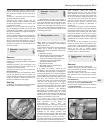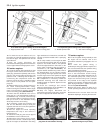
28 Connect the timing light to No 1 cylinder
spark plug lead (No 1 cylinder is at the
transmission end of the engine) as described
in the timing light manufacturer’s instructions.
29 Start the engine, allowing it to idle at the
specified speed, and point the timing light at
the transmission housing aperture. The
flywheel timing mark should be aligned with
the appropriate notch on the timing plate. The
numbers on the plate indicate degrees Before
Top Dead Centre (BTDC).
30 If adjustment is necessary, slacken the
two distributor mounting nuts, then slowly
rotate the distributor body as required until
the flywheel mark and the timing plate notch
are brought into alignment. Once the marks
are correctly aligned, hold the distributor
stationary and tighten its mounting nuts.
Recheck that the timing marks are still
correctly aligned and, if necessary, repeat the
adjustment procedure.
31 When the timing is correctly set, increase
the engine speed, and check that the flywheel
mark advances to beyond the beginning of
the timing plate reference marks, returning to
the specified mark when the engine is allowed
to idle. This shows that the centrifugal
advance mechanism is functioning.
Reconnect the vacuum hose to the
distributor, and repeat the check. The rate of
advance should significantly increase if the
vacuum diaphragm is functioning correctly.
32 When the ignition timing is correct, stop
the engine and disconnect the timing light.
9 TDC sensor - removal and
refitting
2
Removal
1 Depending on engine type, the TDC sensor
is for use with the diagnostic socket located
on the clutch housing, or for the provision of
information on crankshaft position to the
engine management system ECU. When used
in conjunction with the diagnostic socket, a
special instrument and adapter are required
and therefore it will normally be used only by a
Peugeot garage.
2 To remove the sensor, unscrew the
mounting screw or release the clamp as
applicable.
3 Where the sensor forms part of the
diagnostic socket assembly, if it is to be
completely removed, the socket must be
unclipped from its bracket and the remaining
wiring and earth leads disconnected.
Refitting
4 Refitting is a reversal of removal, but the
adjustment procedure for new and used
sensors differs. New sensors have three
extensions on the inner face and the unit
should be inserted through the clamp until the
extensions just touch the flywheel. The clamp
screw is then tightened and clearance is
provided as the flywheel rotates and wears
the ends of the extensions. This method
should not be used when refitting a used
sensor. In this case, cut off the extensions
completely then temporarily insert the sensor
until it touches the flywheel, remove it and
reposition it in the clamp 1.0 mm further out.
Ignition system 5B•7
5B


















